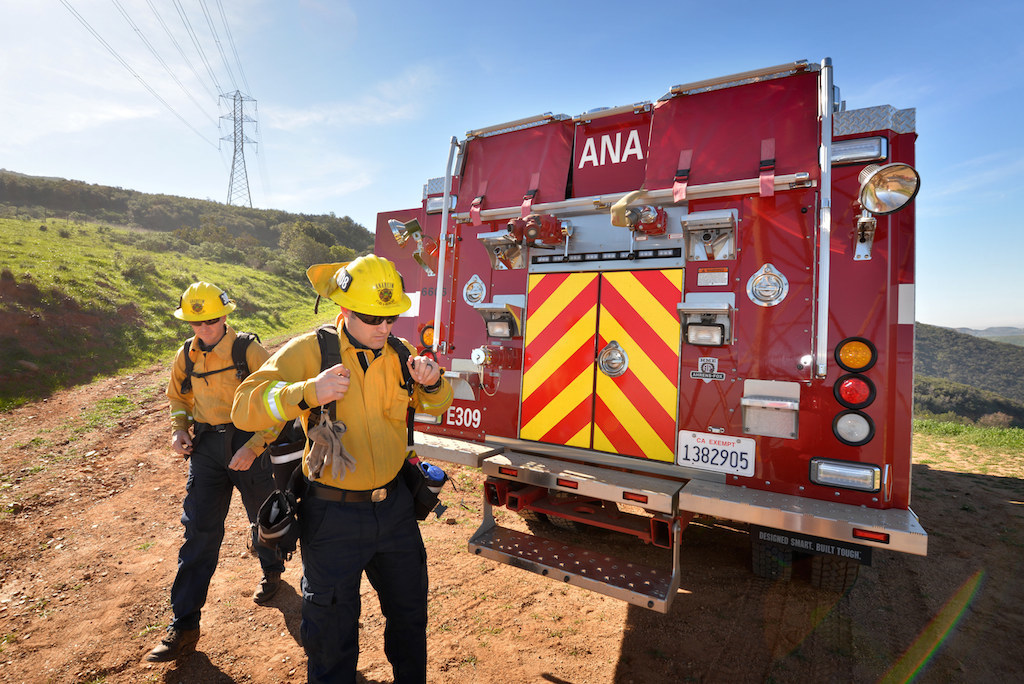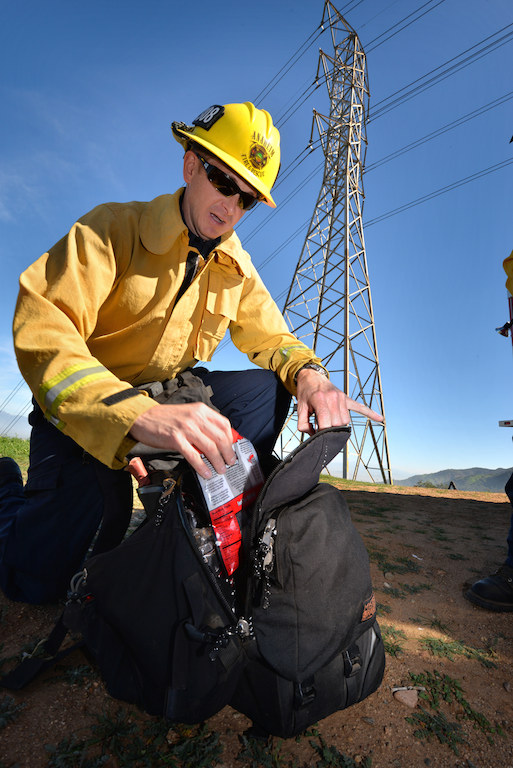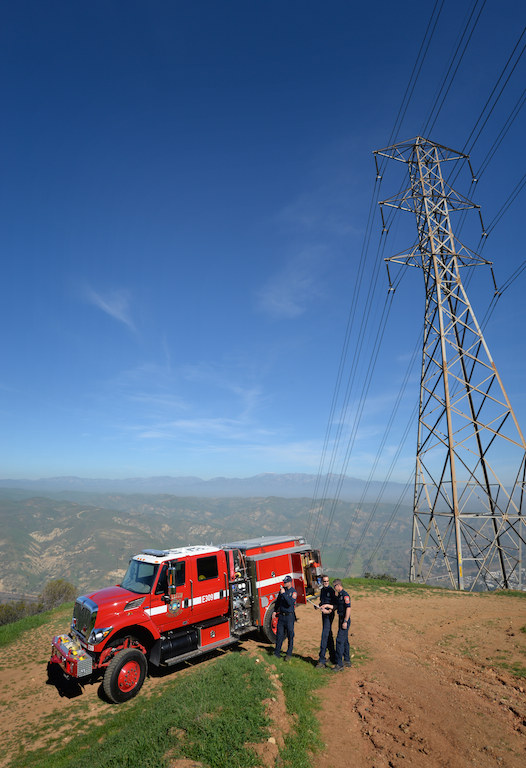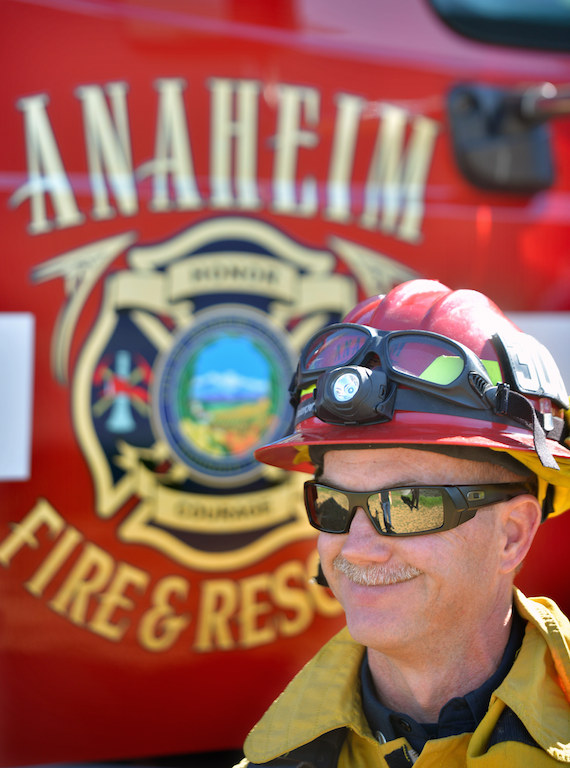The rig rumbles up the steep fire road, some 1,300 feet about the 91 Freeway.
Its massive tires chew and spit out fist-sized rocks as if they were pebbles.
The rig’s engine doesn’t purr – it rumbles, with strength and authority.
It has the decidedly non-descript name of a Type 3 wildland engine — a four-wheel dream not only designed for the great outdoors, but also equipped with Advanced Life Support (ALS) paramedic equipment found on Type 1 fire engines used in the city.
It’s a beast of a specialized fire engine capable of cruising up 20-percent grades and remaining stationary on 10-percent slopes — and packed with enough tents, sleeping bags and other equipment so firefighters can stay reasonably comfortable while deployed on the front lines of a wildfire for days.
Anaheim Fire & Rescue is among a handful of firefighting agencies in Orange County with Type 3 engines.

Firefighter James Moreta, left, and Engineer/Paramedic Chris Fulkerson suit up next to Engine 309. Photo: Steven Georges
Anaheim Fire & Rescue has four of the Type 3 engines — at Stations 1, 8, 9 and 10. The rigs have been used to help knock out blazes not only locally, but also from Oregon to the Mexican border.
“It’s incredible what it does,” says Station 8 Firefighter James Moreta, 42, who outfitted the four Type 3 engines for Anaheim Fire & Rescue to make them as user friendly as possible.
Unlike city fire engines, wildland engines can pump water while they move — -“pump and roll,” in firefighter parlance. The 20-ton rigs carry 500 gallons of water and are equipped with a portable water pump to extract H2O from ponds and other natural water sources.
On a recent afternoon, Moreta and Capt. Jerry George, 48, along with Firefighter Engineer/Paramedic Chris Fulkerson, 33, took Behind the Badge OC on a ride in a Type 3 rig up a rugged fire road past Starr Ranch above Corona, and also past the site of the Coal Canyon wildfire that blew through brush last September.
With tinted windows and room for five firefighters, the four-wheel-drive apparatus sits high above the ground – the eyes of its occupants about nine-feet above the dirt.
Type 1 engines used in the city are equipped with wildland hoses (they are thinner and lighter than standard hoses), but Type 1 rigs are limited to where they can go and what they can do in the wilderness.
Type 3 rigs can go deeper into the wild and closer to fires – and keep firefighters comfortable and ready to handle blazes with tools that are exclusive to the engines.

Engineer/Paramedic Chris Fulkerson of Anaheim Fire & Rescue looks over the isolation kit, part of the medical supplies stored on Engine 309, a Type 3 engine.
Photo by Steven Georges/Behind the Badge OC
These tools include torches for setting “backfires” — fires set to consume the fuel in the path of a wildfire – a chainsaw, hand tools for removing trees and brush to create a holding line around a fire, and enough hose to extend a “hose lay” over ½ mile from the engine.
In addition to these special tools, the Type 3 engines are packed with equipment used to combat traditional structural fires.
Anaheim Fire & Rescue conducts training sessions several times a year on Type 3 engines. Driving them can be unnerving at first for firefighter engineers because the rigs can make it tough for occupants to see the ground when rolling up a steep grade.
And looking out the window and down a steep drop-off also can take getting used to in a Type 3 engine.
Engineers spend a week of training to get the feel of driving a Type 3 apparatus, George says. Training for other firefighters can take longer, and takes places on terrain that mimics where wildfires occur.
Among the Type 3 topics covered in training are deploying fire shelters, which are safety devices of last resort used by wildland firefighters to protect their lives. The shelters are designed to reflect radiant heat, protect against convective heat and trap breathable air so firefighters won’t have to breath in deadly hot gases.

Firefighter James Moreta customized all four of Anaheim Fire & Rescue’s Type 3 engines to make them as user-friendly as possible. Photo: Steven Georges
Cutting lines and making progressive hose lays are other training areas covered in wildfire sessions. So is “flagging,” the art of hanging neon-colored ribbons in trees and bushes to mark an escape route for the firefighters if conditions deteriorate quickly.
When fighting a wildfire, crewmembers carry a pack of personal belongings they keep on the Type 3 rig in case they get stuck in the wild for extended periods. The weight they carry can exceed 70 pounds.
Baby wipes, energy bars, bug spray, bee-sting kits, extra batteries and shoelaces, beef jerky, a whistle and compass, a toothbrush and toothpaste, sunscreen, a GPS device, an extra pair of sunglasses, a headlamp, glow sticks — these are some of the essentials favored by Moreta, George and other wildfire specialists.
Moreta also carries Tapatio sauce.
“That will kill the taste out of a really bad sandwich,” he says with a smile.

Moreta goes through some of the personal gear he packs into a bag for wildfire events. Photo: Steven Georges
 Behind the Badge
Behind the Badge





